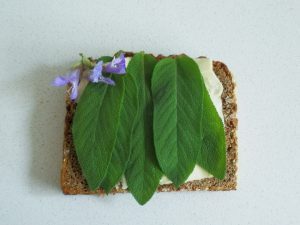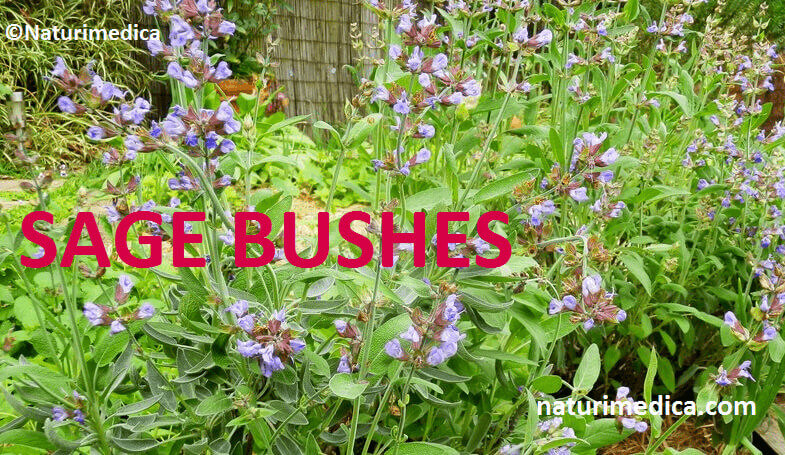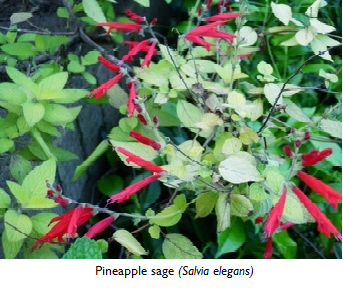Sage bushes are blooming in my garden, it’s time to remind ourselves what a great healing herb sage really is!
Sage is commonly used as a culinary herb but there certainly is nothing ‘common’ about its medicinal powers! To start with, its Latin name, Salvia, is derived from the word salvere, ‘to be saved” as a reference to its curative properties.
Sage belongs to the mint family of plants which includes its more famous cousins such as mint, peppermint, oregano and lemon balm.
There are hundreds of species of sage, most of them are perennials (meaning that once planted they grow for more than two years), fast growers, and require little water making them a favourite with gardeners and cooks alike.
Sage has a very long history of medicinal use going back to the ancient Egyptians and later the Romans and the Greeks. The variety most often used for medicinal purposes is garden sage (Salvia officinalis).
Examples of medicinal use of sage include:
- Boosting brain function and memory – sage is believed to boost the brain’s supply of acetylcholine, a neurotransmitter that is critical to proper brain functioning and memory. In a clinical study published in 2006 in “Neuropsychopharmacology,” researchers found that doses of 300 to 600mg of dried sage leaf significantly improved cognitive performance and mood in 30 healthy volunteers.
- In another placebo controlled study patients with mild to moderate Alzheimer’s disease who were administered 60 drops/day of Salvia officinalis during a 4-month period apparently showed significant cognitive improvement over control subjects (Akhondzadeh 2003). Sage also demonstrated anxiolytic – or anxiety-reducing effects. So now we understand why people who possess the great wisdom of age are called sages!
- Mouth and throat – sage is an effective antiseptic used externally as a gargle against the bacteria that cause gingivitis (some natural mouthwashes contain sage) and inflammatory conditions such as mouth ulcers, bleeding gums, bad breath, sore throat, tonsillitis, and laryngitis. The leaves applied to an aching tooth will often relieve the pain.
- Digestion and gut health – it soothes inflammation of the stomach and the intestinal tract, and eases muscle spasms and indigestion. Helps with digestion of fats.
- Blood sugar regulation – sage may be of value to diabetics as some studies indicate that sage may boost insulin action lowering blood sugar. For people with diabetes it may be worth considering drinking sage tea in conjunction with the treatment (however always talk to your doctor before modifying your treatment in any way).
- Alleviating excessive perspiration and fevers – when taken as a tea, sage has a calming effect on sweat glands and reduces sweating (some researchers say by as much as 50%). As such it can be used to alleviate fevers or night sweats experienced by many menopausal women.
- Here is a recipe for sage tea for menopause symptoms: for a 1-3 day supply take 2 tablespoons of finely chopped fresh leaves or 1 tablespoon of dried leaves and cover with 500 ml warm water with the juice of one lemon. Cover the jar and leave overnight. Strain, keep in a glass container in the fridge. Drink straight or in a little juice as needed.
- Cholesterol lowering – one human pilot trial claimed that sage tea ingestion improved lipid profiles by lowering plasma LDL cholesterol and total cholesterol levels as well as increasing antioxidant defences (Sa 2009).
- Cosmetic use – the most common cosmetic use of sage leaves is for hair treatments. An infusion of fresh sage leaves can be applied to the scalp to keep hair dark, shiny, and healthy. Alternatively the infusion can be used as a hair rinse applied just before drying the hair. Sage is also used in perfumes, toothpaste and mouth rinses.
- Food preservation and antioxidant activity – for a long time sage has been used in preserving of foods. Now it is known that it contains powerful antioxidants which slow spoilage.
Native Americans use sage for spiritual purification ceremonies in the form of smudge sticks which are lit and the aromatic, silvery smoke is wafted around people, rooms, houses to dispel negative energies and emotions.
Cautions – Sage should not taken fresh in larger quantities by pregnant women (it can stimulate the muscles of the uterus) and by people who experience epileptic seizures. Do not use herbal extracts and essential oil without prescription from a knowledgeable herbalist.
Pineapple sage (Salvia elegans)
Pineapple sage grows wild in scrub forests in Mexico and Guatemala but it’s also perfectly happy in sunny gardens in Sydney! When bruised, the foliage has the aroma of ripe pineapple, hence the name.
Pineapple sage has tall stalks of bright red, clustered flowers that attract butterflies and bees. It’s a really attractive looking plant that will add beautiful colours (light green and blood red) to any garden. This sage variety has a number of culinary uses (see below for a few examples).
Pineapple sage recipes
- Infused water – take 1 litre of filtered water, add 8-10 slightly bruised pineapple sage leaves, add 2-3 cut strawberries plus a few slices of lemon and leave it for a few hours, ideally in the sun, to release all the goodness as well as colour into the water. This is a great tasting and refreshing drink, it can also be chilled in the fridge.
- Take sliced leaves, mix them with cottage cheese or quark and fresh pineapple pieces and have with wholemeal rye bread or sourdough spelt bread.
- Crush the leaves to release the flavours and add them to a fruit salad. Let it stand for 5-10 minutes for the leaves to infuse the salad with their wonderful aroma.
- Add a spring with flowers to garnish iced tea.
Culinary use of sage
Sage is a great culinary herb and here are a few suggestions for you to start with:
- Fried sage – slice sage 3-4 leaves, saute lightly in butter with minced garlic for a minute or so. Add a little chopped parsley and toss with wholemeal pasta. Alternatively serve on baked chicken, fish or meat (delicious!!).
- Leaves can be mixed with onion for chicken stuffing. Use 2-3 leaves only as it has a strong flavour.
- Add sage to rich, fatty meats such as lamb, pork and duck. It will help fat digestion.
- Make sage vinegar and sage butter.
- Sage mashed potatoes taste just great! I often add the sautéed sage (see above) on the top of mashed or baked potatoes.
 Sage sandwiches –this is my favourite sage dish, it’s very simple and super quick to prepare. Cut 1-2 slices of a heavy wholemeal rye bread, spread a thick layer of softened organic butter, sprinkle with Celtic salt and top with chopped fresh sage (you could also use dried sage but it’s not the same).
Sage sandwiches –this is my favourite sage dish, it’s very simple and super quick to prepare. Cut 1-2 slices of a heavy wholemeal rye bread, spread a thick layer of softened organic butter, sprinkle with Celtic salt and top with chopped fresh sage (you could also use dried sage but it’s not the same).
Chew well, relax and take in all the goodness! Have on its own or with soup or salad. Sage feeds the brain, butter and heavy rye bread have good fats, minerals and fibre, and are energy-rich.
Often I don’t even slice the sage leaves but just put the whole leaves on a piece of bread like this – see my photo on the right. Sage flowers are optional although they are also edible:)
All photos in this post are from my garden/ kitchen. I can say from experience that sage is easy to grow and, being a perennial plant, once planted it will return year after year. It’s worth having a bush or two in your garden or a sunny balcony for fresh pickings!
Summary
Sage is medicinal, culinary, decorative and spiritual. With so many uses I hope you will be inspired to add sage to your foods on a regular basis!
About 5-7 fresh leaves per day is plenty as this was a therapeutic dose used in a few studies mentioned above. If you are into baking I even have a cake recipe using pineapple sage, send me an email if you are interested in making it.
Good health and blessings
Joanna Sochan
Holistic Health and Lifestyle Therapist
Natural and Lifestyle Solutions for Abundant Health and Wellbeing
References
- Akhondzadeh S, Noroozian M, Mohammadi M, Ohadinia S, Jamshidi A, Khani M. “Salvia officinalis extract in the treatment of patients with mild to moderate Alzheimer’s disease: a double blind, randomized and placebo-controlled trial”. J Clin Pharm Ther. Feb 2003; 28 (1): 53–9.
- Dweck A. “The folklore and cosmetic use of various Salvia species”. Wiltshire, 1987.
- D.O. Kennedy et al. “Effects of Cholinesterase Inhibiting Sage On Mood, Anxiety And Performance on A Psychological Stressor Battery”; Neuropsychopharmacology; April 2006
- http://www.drugs.com/npp/sage.html
- Eric Yarnell, Kathy Abascal. “Herbs for Treating Herpes Zoster Infections” Alternative & Complementary Therapies. Jun 2005, Vol. 11, No. 3: 131-134
- Henriette’s Herbal online
- Sa CM, Ramos AA, Azevedo MF, Lima CF, Fernandes-Ferreira M, Pereira-Wilson C. “Sage tea drinking improves lipid profile and antioxidant defenses in humans.” Int J Mol Sci. 10(9): 2009, 9; 3937-50.
Additional resources
- Gotu kola: uses and benefits for skin, stomach ulcers and memory
- Know and love your herbs – Coriander
- Know and love your herbs – Lemon balm
- Bee pollen for weight loss – a great but totally overlooked strategy!
- Sage and rosemary honey: benefits and recipe
Disclaimer: The above material is for informational and/or educational purposes only. It should not be used to self-diagnose and it is not a substitute for a medical advice, diagnosis, treatment, prescription or recommendation. All viewers of this content, especially those taking prescription or over-the-counter medications, should not make any changes in their health regimen or diet before first consulting a doctor or other qualified health provider with any questions they may have regarding a medical condition or their particular circumstances.

Joanna Sochan is a Natural Therapist and founder of Naturimedica Holistic Health & Wellness. She has a passion for helping clients transform their lives by becoming healthy and well naturally. Joanna has 10+ years experience in clinical practice and has special interest in solving complex cases, functional medicine testing, gut health, sleep, fatigue and chronic pain. She guides clients through her tailored programs and eCourses as well as helping them individually (mostly online) Australia-wide. View full bio.
 Print This Post
Print This Post 



Very helpfull. Thanks Joanna.
Julia A Vincent, RN who specialises in Natural Therapies.
B App Sc (Systems Agriculture) HAC UWS
That’s great! Thank you for letting me know.
Thanks for this detailed article, Joanna. Sage is one of my all-time favs!
As one medieval saying goes: “why should a man die while sage grows in his garden?”
Best wished and keep up the amazing work!
Sage grows so well in my garden:)
Just stumbled across your site when listening looking for parasite cleansing alternatives and have found a bunch of awesome stuff of your site! So thank you for sharing!
With love from
Coffs Harbour
Xo jemma
Thank you for letting me know Jemma! I’m happy I could help you a little:)
Thank you for an informative article and I would love your pineapple sage recipe as my plant is blooming!
Thanks again
Hi Sharon
Yes, my pineapple sage bush is blooming, too! Here is the recipe:
Pineapple Sage Cake
2 cups flour
1 cup butter, at room temperature
1 cup sugar
1/4 cup honey
5 eggs
2 tablespoons chopped pineapple sage leaves (the small, new leaves have the most pineapple flavour)
3 tablespoons coarsely chopped red pineapple sage flowers*
1 teaspoon grated lemon peel
4 tablespoons well-squeezed, chopped pineapple
1 teaspoon baking powder
Cream the butter and the sugar until very light and fluffy. Beat in the honey. Add the eggs one at a time, making sure to beat for one minute after each addition. Beat in the sage leaves, flowers and lemon peel. Stir the dry ingredients together and add to the butter mixture.
Fold these together gently, until just blended. Pour into four miniature loaf pans. Bake in a pre-heated oven in around 180C for approximately 45 minutes, or until golden brown. A toothpick inserted in the middle should come out clean. Cool for 10 minutes on a rack, then turn out of pans and continue to cool.
The other way is to make muffins instead of little cakes.
*The recipe can be made without the flowers, if the plant has stopped flowering and no flowers are available. No adjustments to the recipe are necessary.
Source: Henriette’s Herbal
Enjoy!
Joanna
I love your sage sandwich idea and can I have the recipe for the pineapple sage cake .Mx
Thank you for reading! Will send the pineapple sage cake recipe asap.
All the best
Joanna